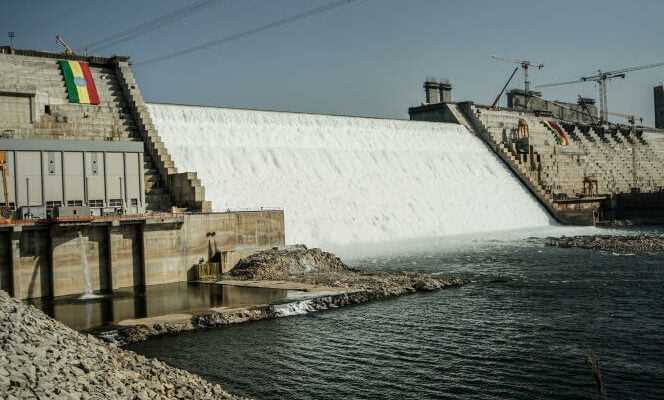To not miss any African news, subscribe to the “Monde Afrique” newsletter from this link. Every Saturday at 6 am, find a week of news and debates treated by the editorial staff of “Monde Afrique”.
After more than ten years of work and controversy with Egypt and Sudan, Ethiopia officially launched on Sunday February 20 the production of electricity from its great Renaissance dam on the Blue Nile.
This is “the birth of a new era”launched the Ethiopian Prime Minister Abiy Ahmed while chairing Sunday the launch of the production of Gerd (Grand Ethiopian Renaissance Dam), controversial project of several billion dollars, noted an AFP correspondent. “This is good news for our continent and for the downstream countries with which we aspire to work together”he added on Twitter.
Accompanied by many of the country’s top officials, Abiy Ahmed toured the power plant and clicked a series of switches on an electronic screen to initiate production from the dam.
“This great dam was built by the Ethiopians, but for the benefit of all Africans, so that all our brothers and sisters in Africa can benefit from it”said a senior official attending the inauguration. “This day, for which Ethiopians have sacrificed so much, for which Ethiopians have hoped so much, for which they have prayed so much, this day is finally here”he added while presiding over the short launch ceremony.
An estimated cost of 3.7 billion euros
When the project was launched, each civil servant was asked to contribute one month’s salary to the financing of the dam. Subsequently, many government loans had also strained the savings of Ethiopians.
Getachew Reda, spokesman for the Tigray People’s Liberation Front (TPLF), which has been at war with government forces since November 2020 in the north of the country, accused Mr. Abiy of taking credit for a project launched under a government then led by the Tigrayans. ‘Today #AbiyAhmed is trying to cash in on a project he once openly denigrated as a meaningless publicity stunt’he tweeted.
But on Sunday, various Ethiopian officials praised Abiy Ahmed’s efforts to complete funding for a long-dragging and near-failure project. “Our country has lost so much, especially financially, due to the delays in the works”, underlined the general manager of the Kifle Horo project, during his opening remarks. In the absence of precise official accounts, the total cost of the project was estimated by the experts at 4.2 billion dollars (3.7 billion euros).
The Gerd constitutes, since the launch of the project in 2011, a dispute with Sudan and Egypt, both tributaries of the Nile for their hydraulic resources. Cairo invokes a “historical law” on the river, guaranteed since a treaty signed in 1929 between Egypt and Sudan, then represented by the United Kingdom, a colonial power. Egypt had obtained a right of veto on the construction of projects on the river.
1.8 kilometers long
In 1959, after an agreement with Khartoum on water sharing, Egypt was allocated a quota of 66% of the annual flow of the Nile, against 22% for Sudan. Not being a party to these agreements, Ethiopia has never considered itself bound by them and, in 2010, a new treaty signed by the countries of the Nile basin, which originates in Uganda, abolished the right Egyptian veto and authorized irrigation projects and hydroelectric dams.
“As you can see, this water generates energy and then continues to flow as before towards Sudan and Egypt, contrary to rumors that the Ethiopians wanted to block the water to starve them”said Abiy Ahmed.
The Egyptian Foreign Ministry regretted on Sunday that “Ethiopia persists in its violations of the signed 2015 Declaration of Principles” between the three countries and providing for the search for a negotiated solution.
Seized in the summer of 2021, the UN recommended that the three countries continue their talks under the aegis of the African Union (AU). Cairo and Khartoum, worried about their water supply, had asked Addis Ababa to stop filling the dam.
Ethiopia had nevertheless proceeded last July to the second phase of filling the dam, announced as one of the largest in Africa with an initial production target of 6,500 megawatts, revised downwards to 5,000 MW, i.e. double the current production of Ethiopia. According to Ethiopian state media, the initial production of the Gerd is around 375 MW with the commissioning of a first turbine, out of the thirteen of the entire dam.
A second turbine should be started within a few months and the whole dam should be fully operational in 2024, Kifle Horo told AFP. Located on the Blue Nile, about thirty kilometers from the Sudanese border, the great Renaissance dam is 1.8 kilometers long and 145 meters high.
